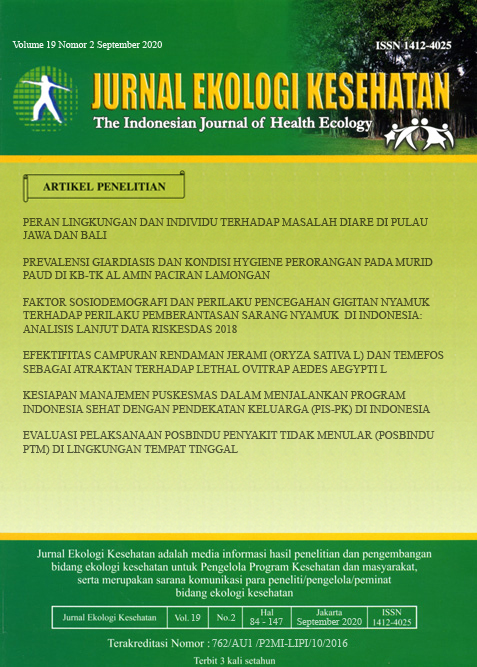PREVALENSI GIARDIASIS DAN KONDISI HYGIENE PERORANGAN PADA MURID PAUD DI KB-TK AL AMIN PACIRAN LAMONGAN
Abstract
ABSTRACT
Small intestine infection caused by Giardia lamblia (giardiasis) occurs mostly in children living in developing country with poor sanitation. This study aims to determine the risk of giardiasis and personal hygiene conditions in pre-school students at KB-TK Al Amin Paciran Lamongan aged 2-6 years. Number of samples were 61 students, the dependent variable was the incidence of giardiasis, and independent variable was personal hygiene including nail hygiene, hand washing habit, footwear habit, and defecating habits. The result showed that 5 out of 61 students (8,2%) were infected with Giardia lamblia. All children (100%) with giardiasis had poor nail hygiene, footwear habit, and defecating habit. As many as 80% of students with giardiasis have poor handwashing habits. Students with poor footwear habit (OR=43,71; 95% CI 3,98-2046,9); open defecation habits (OR=13,33; 95% CI 1,40-628,05); poor nail hygiene (OR=12,31; 95% CI 1,29-580,49); poor hand washing habits (OR=5,73; 95% CI 0,5-290,96) had a greater risk of developing giardiasis. Supervision and healthy behavior are highly recommended, including using footwear when playing on the ground, defecating in the latrine, maintaining nail hygiene, and washing hands with soap before eating or after defecating.
Keywords: Prevalence, giardiasis, personal hygiene, pre-school students
ABSTRAK
Infeksi usus halus disebabkan oleh Giardia lamblia (giardiasis) banyak terjadi pada anak-anak yang tinggal di negara berkembang dengan tingkat sanitasi buruk. Penelitian ini bertujuan untuk mengetahui risiko terjadinya giardiasis dan kondisi hygiene perorangan pada murid PAUD di KB-TK Al Amin Paciran Lamongan usia 2-6 tahun. Jumlah sampel adalah 61 murid, variabel dependen adalah kejadian giardiasis, dan variabel independen adalah hygiene perorangan meliputi kebersihan kuku, kebiasaan mencuci tangan, kebiasaan menggunakan alas kaki, dan kebiasaan buang air besar (BAB). Hasil penelitian menunjukkan bahwa 5 dari 61 murid (8,2%) terinfeksi Giardia lamblia. Seluruh murid (100%) dengan giardiasis mempunyai kebersihan kuku, kebiasaan menggunakan alas kaki dan kebiasaan BAB yang kurang baik. Sebanyak 80% murid dengan giardiasis mempunyai kebiasaan mencuci tangan yang kurang baik. Murid dengan kebiasaan menggunakan alas kaki kurang baik (OR=43,71; 95% CI 3,98–2046,9); kebiasaan BAB sembarangan (OR=13,33; 95% CI 1,40–628,05); kebersihan kuku kurang baik (OR=12,31; 95% CI 1,29-580,49); kebiasaan mencuci tangan yang kurang baik (OR=5,73; 95% CI 0,5–290,96) mempunyai risiko lebih besar terkena giardiasis. Pengawasan dan berperilaku hidup sehat sangat dianjurkan antara lain menggunakan alas kaki ketika bermain di tanah, membiasakan BAB di jamban, menjaga kebersihan kuku, dan mencuci tangan dengan sabun sebelum makan atau setelah buang air besar.
Kata kunci: Prevalensi, giardiasis, hygiene perorangan, murid PAUD
References
Anzani, B. P. and Saftarina, F. (2019) ‘Penatalaksanaan Diare pada Anak Usia 2 Tahun dengan Pendekatan Kedokteran Keluarga Management Of Diarrhea in Childern 2 Years with Family Medicine Approach’, Majority, 8, pp. 24–31.
Arindata, A. N., Prasetyo, R. H. and Budiono (2017) Faktor Risiko Giardiasis pada Siswa Sekolah Dasar Negeri Pulau Mandangin 06, Kecamatan Sampang, Kabupaten Sampang, Jawa Timur. Universitas Airlangga.
Artika, M., Nurhayati and Alioes, Y. (2017) ‘Hubungan Kebiasaan Mencuci Tangan dan Memotong Kuku dengan Kejadian Giardiasis Asimtomatik’, Jurnal Kesehatan Andalas, 6(1), p. 70. doi: 10.25077/jka.v6i1.647.
Bachtiar, Z. A. (2018) Perbandingan Prevalensi Giardiasis dan Status Gizi Anak pada Daerah dengan Akses Jamban Sehat Kurang Memadai dan Memadai. Universitas Airlangga.
Bartelt, L. A. and Sartor, R. B. (2015) ‘Advances in Understanding Giardia: Determinants and Mechanisms of Chronic Sequelae’, F1000Prime Reports, 7(62).
Campbell, S. J. et al. (2016) ‘Water, Sanitation and Hygiene Related Risk Factors for Soil-Transmitted Helminth and Giardia Duodenalis Infections in Rural Communities in Timor-Leste’, International Journal for Parasitology, 46(12), pp. 771–779. doi: 10.1016/j.ijpara.2016.07.005.
Centers for Disease Control and Prevention (2015) Giardia.
Chin, Y. T. et al. (2016) ‘Prevalence and Risk Factors of Intestinal Parasitism Among Two Indigenous Sub-ethnic Groups in Peninsular Malaysia’, Infectious Diseases of Poverty. Infectious Diseases of Poverty, 5(1). doi: 10.1186/s40249-016-0168-z.
Darlan, D. M. et al. (2018) ‘Correlation Between Iron Deficiency Anemia and Intestinal Parasitic Infection in School-Age Children in Medan’, IOP Conference Series: Earth and Environmental Science, 125(1), pp. 4–10. doi: 10.1088/1755-1315/125/1/012059.
Diarthini, N. L. P. E. et al. (2018) ‘Blastocystis and Other Intestinal Parasites Infections in Elementary School Children in Dukuh Village, Karangasem District, Bali’, Indonesian Journal of Tropical and Infectious Disease, 7(3), p. 57. doi: 10.20473/ijtid.v7i3.7323.
Halliez, M. C. M. and Buret, A. G. (2013) ‘Extra-intestinal and Long Term Consequences of Giardia Duodenalis Infections’, World Journal of Gastroenterology, 19(47), pp. 8974–8985. doi: 10.3748/wjg.v19.i47.8974.
Harun, H., Sennang, N. and Rusli, B. (2019) ‘Giardiasis’, Healthy Tadulako Journal, 5(3), pp. 1–80.
Ivanov, A. I. (2010) ‘Giardia and Giardiasis’, Bulgarian Journal of Veterinary Medicine, 13(2), pp. 65–80.
Kementerian Kesehatan RI Badan Penelitian dan Pengembangan (2018) ‘Hasil Utama Riset Kesehatan Dasar’, Kementrian Kesehatan Republik Indonesia, pp. 1–100. doi: 1 Desember 2013.
Leung, A. K. C. et al. (2019) ‘Giardiasis: an Overview.’, Recent Patents on Inflammation & Allergy Drug Discovery, 13(2). doi: 10.2174/1872213x13666190618124901.
Mauludyahwati, L. et al. (2018) ‘Manifestasi Ekstraintestinal Giardiasis : Reactive Arthritis Manifestasi Ekstraintestinal Giardiasis : Reactive Arthritis’, (March).
Ramadhan, M. A. (2019) Prevalensi dan Faktor Giardiasis pada Siswa Sekolah Dasar di Kelurahan Tanah Kali Kedinding, Surabaya. Universitas Airlangga.
Saraswati, A. M. and Nurdian, Y. (2018) ‘Anemia in the Children of Migratory Farm Workers that Infested By Giardia intestinalis’, (May), pp. 7–10.
Suliman, M. A. et al. (2019) ‘Prevalence of Intestinal Parasitic Infections and Associated Risk Factors among School Children in White Nile State, Sudan Toxoplasmosis View project schistosomiasis View project Prevalence of Intestinal Parasitic Infections and Associated Risk Factors am’, Journal of Infectious Disease and Diagnosis, 4(1), pp. 8–11. doi: 10.4172/2576-389X.1000125.
Valenzuela C (1993) ‘Dos Soluciones Para la Estimacion de “Odds Ratios” Con Ceros [2 Solutions for Estimating Odds Ratios with Zeros]’, Rev Med Chil, 121(12), pp. 1441–4.



















